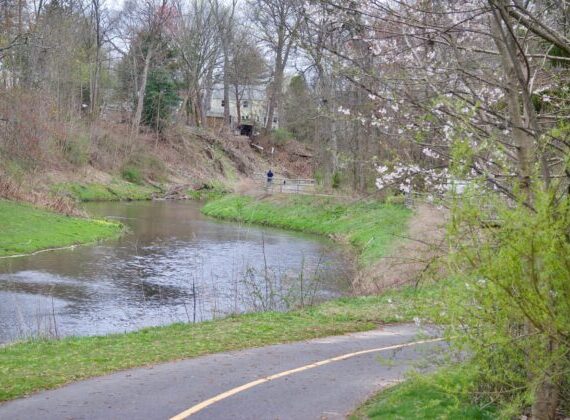Longtime visitors to this site no doubt recall reading that sidewalks are not decorative borders, even if they’re routinely obstructed by people who believe the concrete was poured for cosmetic reasons only.
So, it comes to no surprise to see people — namely City of Hartford employees, and others — show no understanding of what the space between the grass and travel lane is intended for within the Frog Hollow roundabout.
If this were the only place on the planet where this technology was present, I would feel less annoyed; however, most drivers act utterly bewildered by roundabouts in general, even though they have existed for over 200 years. More about that in a moment.

That faded brick red ring with yellow directional markings? That’s called a truck apron.
It is meant to do one thing, and that’s not any of the uses documented in these photos taken several weeks apart.
It’s not for short- or long-term parking of vehicles, whether they’re disabled or part of maintenance. The truck apron is not intended for storing signs meant to alert drivers to nearby construction or said maintenance.
In fact, both of those misuses interfere with the truck apron’s function.
The purpose of a roundabout is keep traffic moving at a slow speed. If all its users act like they are part of society, then this is achieved as people take turns entering the space — whether on foot, bike, or encased in tons of metal and plastic — predictably and respectfully. Having a small degree of confusion can be helpful, if people’s response to confusion is to slow down. A well-built roundabout is not one with a lot of lanes, nor is it super wide.
But, for people driving large trucks and buses, a roundabout turn might prove to be too tight.
Truck drivers: meet your friend, the truck apron.

As the US DOT puts it, the truck apron “may be used to provide additional traversable area around the central island for large semi-trailers.” The vehicle speed is still slowed down, but instead of creating a traffic jam while a driver stops, reverses, turns, et cetera, the driver is able to carefully drive partially onto this surface.
If someone has thoughtlessly scattered signs or beached a vehicle on the truck apron, they have prevented truck drivers from having access to this space.
Many years and jobs ago I had a manager who put signs on every surface in the break/copy room. Signs on signs. There were so many signs that you would not even notice if a new one was added. As a result, nobody paid attention and missed what may have been helpful information. I think about this when I see the clutter of road maintenance and construction signs. I would love to see any credible study that shows having more hi-vis and caution signs does anything for safety, though there was one about workplace safety . . . and signs point to no. Besides preventing the truck apron from fulfilling its purpose, placing signs on it also potentially makes nothing safer for those doing maintenance nearby, and that’s something that even Hartford’s DPW ought to think about.

